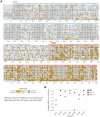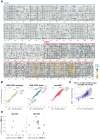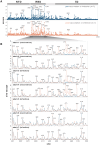This is a preprint.
Spike mutations that affect the function and antigenicity of recent KP.3.1.1-like SARS-CoV-2 variants
- PMID: 40894770
- PMCID: PMC12393327
- DOI: 10.1101/2025.08.18.671001
Spike mutations that affect the function and antigenicity of recent KP.3.1.1-like SARS-CoV-2 variants
Abstract
SARS-CoV-2 is under strong evolutionary selection to acquire mutations in its spike protein that reduce neutralization by human polyclonal antibodies. Here we use pseudovirus-based deep mutational scanning to measure how mutations to the spike from the recent KP.3.1.1 SARS-CoV-2 strain affect cell entry, binding to ACE2 receptor, RBD up/down motion, and neutralization by human sera and clinically relevant antibodies. The spike mutations that most affect serum antibody neutralization sometimes differ between sera collected before versus after recent vaccination or infection, indicating these exposures shift the neutralization immunodominance hierarchy. The sites where mutations cause the greatest reduction in neutralization by post-vaccination or infection sera include receptor-binding domain (RBD) sites 475, 478 and 487, all of which have mutated in recent SARS-CoV-2 variants. Multiple mutations outside the RBD affect sera neutralization as strongly as any RBD mutations by modulating RBD up/down movement. Some sites that affect RBD up/down movement have mutated in recent SARS-CoV-2 variants. Finally, we measure how spike mutations affect neutralization by three clinically relevant SARS-CoV-2 antibodies: VYD222, BD55-1205, and SA55. Overall, these results illuminate the current constraints and pressures shaping SARS-CoV-2 evolution, and can help with efforts to forecast possible future antigenic changes that may impact vaccines or clinical antibodies.
Figures






Similar articles
-
Limited Variation between SARS-CoV-2-Infected Individuals in Domain Specificity and Relative Potency of the Antibody Response against the Spike Glycoprotein.Microbiol Spectr. 2022 Feb 23;10(1):e0267621. doi: 10.1128/spectrum.02676-21. Epub 2022 Jan 26. Microbiol Spectr. 2022. PMID: 35080430 Free PMC article.
-
Establishment of human post-vaccination SARS-CoV-2 standard reference sera.J Immunol Methods. 2024 Jul;530:113698. doi: 10.1016/j.jim.2024.113698. Epub 2024 May 31. J Immunol Methods. 2024. PMID: 38823574 Free PMC article.
-
Prescription of Controlled Substances: Benefits and Risks.2025 Jul 6. In: StatPearls [Internet]. Treasure Island (FL): StatPearls Publishing; 2025 Jan–. 2025 Jul 6. In: StatPearls [Internet]. Treasure Island (FL): StatPearls Publishing; 2025 Jan–. PMID: 30726003 Free Books & Documents.
-
Antibody tests for identification of current and past infection with SARS-CoV-2.Cochrane Database Syst Rev. 2022 Nov 17;11(11):CD013652. doi: 10.1002/14651858.CD013652.pub2. Cochrane Database Syst Rev. 2022. PMID: 36394900 Free PMC article.
-
Hyperimmune immunoglobulin for people with COVID-19.Cochrane Database Syst Rev. 2023 Jan 26;1(1):CD015167. doi: 10.1002/14651858.CD015167.pub2. Cochrane Database Syst Rev. 2023. PMID: 36700518 Free PMC article.
References
Publication types
LinkOut - more resources
Full Text Sources
Miscellaneous
